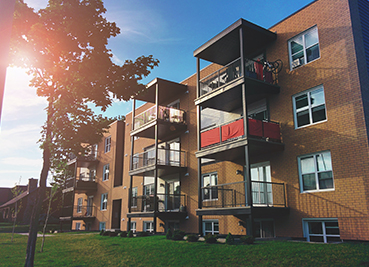
As seen in CREJ Multifamily Properties Quarterly
In order to address the ongoing housing affordability crisis, many municipalities and low income housing providers are turning to the new construction of larger affordable housing properties to solve the shortfall in supply of affordable housing and maximize financing sources available for the construction and operation of these types of multifamily assets. This move is due in part to rising inflation, which is driving the cost of maintaining and rehabilitating older affordable housing assets too high for many owners to keep up with. However, the single largest driver of the prohibitively expensive operating costs associated with aging affordable housing assets is the lack of funding sources available to address ongoing capital expenditures and deferred maintenance needs after initial funding sources have been depleted.
Older affordable housing assets also tend to be quite small relative to newly constructed affordable housing communities. Larger properties can be a powerful tool in the quest to unlock value in aging affordable housing assets by capitalizing on economies of scale and leading to a net increase in the affordable housing stock. Additionally, larger properties can help to reduce the operating costs of low-income or affordable housing communities through green features, such as energy-efficient appliance packages and low-flow toilets. By reducing the operating costs, newly constructed low-income or other affordable housing assets become more competitive investments compared to older properties that require more upkeep to remain viable. Additionally, by reducing the operating expenses of affordable housing communities, stakeholders can generate greater investor appetite for investments in rent restricted assets by increasing investor returns.
Affordable housing is in short supply and critically needed in cities across the United States, but the need is especially acute in large metro areas, such as Denver, that have experienced double-digit rent growth in recent years. Affordable housing communities provide low income individuals and families with stable, high-quality housing that fits within their financial means, if they can secure placement in one of these communities at all due to substantial waiting lists. According to the National Low-Income Housing Coalition, “Each of the 50 largest metropolitan areas in the U.S. have a shortage of rental homes affordable and available for renter households with household incomes below 50% of area median income and 32 of the 50 largest metropolitan areas in the U.S. have a cumulative shortage of affordable and available rental homes for all renters with household incomes up to 80% of AMI.”
Affordable housing assets are typically subsidized by government programs, such as the Low-Income Housing Tax Credit program, and other state and municipal financing sources. However, the vast majority of programs designed to finance the construction and operation of affordable housing projects are heavily front-end loaded, leading to a shortfall in funds that are available to maintain high-quality assets in later years of operation. Additionally, many of the existing rent-restricted properties do not have sufficient replacement reserves for badly needed repairs and general maintenance. Maintaining high-quality properties can be expensive, and it’s difficult to access the capital infusions necessary to address deferred maintenance in aging assets.
Further exasperating the housing affordability crisis, many rent restricted or low-income rental properties are aging quickly and falling into disrepair while still within their deed-restricted affordability periods. In addition, many of these assets are in desperate need of upgrades and improvements to maintain their viability as high quality rental housing that fits within the renter’s financial constraints. As a result, many rent-restricted or low-income rental properties fall into disrepair as deferred maintenance items start piling up and remain unaddressed. Given the shortfall in replacement reserves and the lack in availability of fresh funding sources to maintain these types of assets, purveyors of affordable housing are left without financially feasible options to maintain high quality accommodations. This creates additional barriers to maintaining affordability for low income individuals and families as their options become less appealing and the affordable housing stock is reduced.
I can attest to the challenges associated with operating an aging affordable housing asset. In December, we represented a nonprofit that operates affordable housing in the disposition of several affordable housing assets. This group was facing many of the challenges discussed here and needed to determine how to best leverage its available resources. Several major deferred maintenance items were in desperate need of repair at one of the properties that was originally constructed in the 1970s, but the nonprofit was not able to identify fresh funding sources that could be utilized to rehabilitate the asset. After a long discussion with all stakeholders involved, this nonprofit decided that its resources were best allocated to the development of a new affordable housing community that can secure fresh LIHTC funding, as well as several other state and municipal funding sources. We were able to identify multiple potential buyers that committed to maintaining affordability at the properties within a very short amount of time. As a result, our client was able to move its resources into a new construction project that would cerate a net increase in the affordable housing stock.




